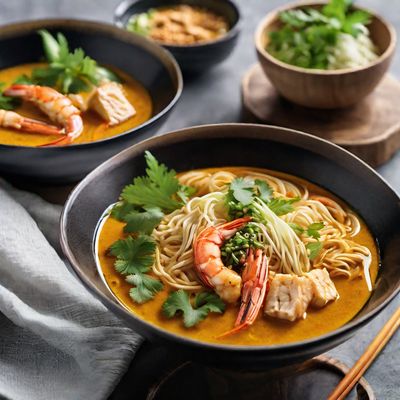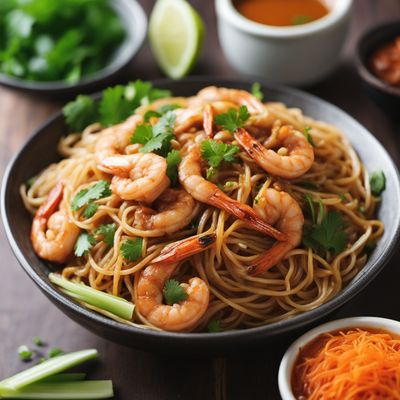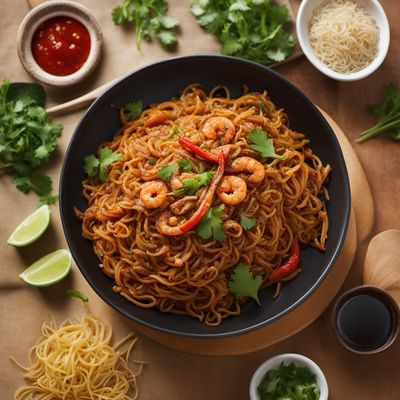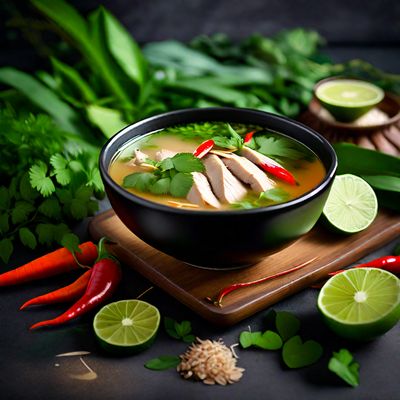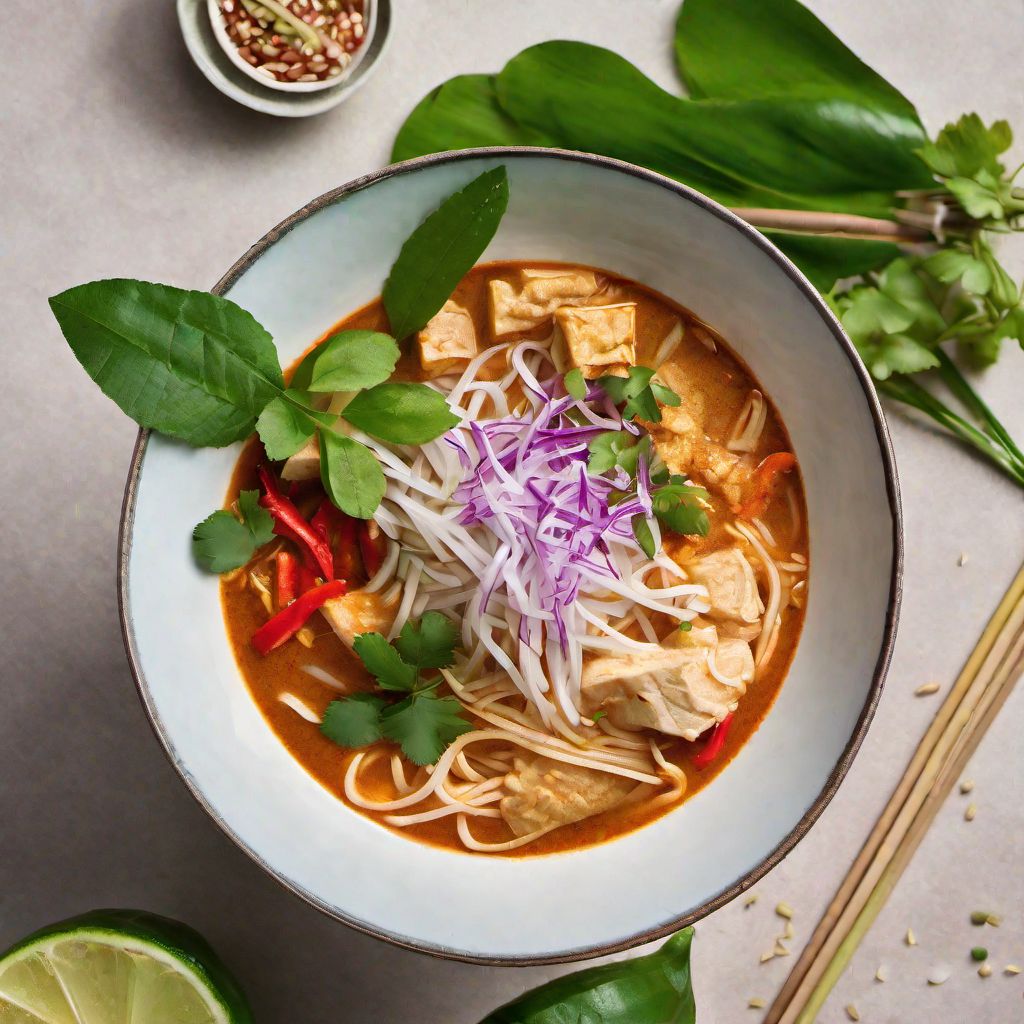
Recipe
Thai Coconut Curry Noodle Soup
Tantalizing Thai Coconut Laksa
4.9 out of 5
Indulge in the vibrant flavors of Thai cuisine with this delectable Thai Coconut Curry Noodle Soup. Bursting with aromatic herbs and spices, this dish will transport you to the bustling streets of Thailand. The rich and creamy coconut broth combined with the fragrant curry paste creates a harmonious balance of flavors that will leave you craving for more.
Metadata
Preparation time
20 minutes
Cooking time
15 minutes
Total time
35 minutes
Yields
4 servings
Preparation difficulty
Easy
Suitable for
Vegan, Vegetarian, Gluten-free, Dairy-free, Nut-free
Allergens
Soy (tofu)
Not suitable for
Paleo, Keto, Low-carb, High-protein, Atkins
Ingredients
While the original Malaysian Laksa is known for its bold and spicy flavors, this Thai adaptation incorporates the distinct Thai flavors of lemongrass, galangal, and kaffir lime leaves. The use of Thai curry paste adds a unique depth of flavor to the dish, making it a delightful fusion of Malaysian and Thai cuisines. We alse have the original recipe for Laksa, so you can check it out.
-
200g (7 oz) rice noodles 200g (7 oz) rice noodles
-
1 tablespoon vegetable oil 1 tablespoon vegetable oil
-
1 onion, thinly sliced 1 onion, thinly sliced
-
2 cloves garlic, minced 2 cloves garlic, minced
-
1 tablespoon Thai red curry paste 1 tablespoon Thai red curry paste
-
1 stalk lemongrass, bruised 1 stalk lemongrass, bruised
-
2 slices galangal 2 slices galangal
-
4 kaffir lime leaves 4 kaffir lime leaves
-
400ml (14 fl oz) coconut milk 400ml (14 fl oz) coconut milk
-
500ml (2 cups) vegetable broth 500ml (2 cups) vegetable broth
-
200g (7 oz) tofu, cubed 200g (7 oz) tofu, cubed
-
100g (3.5 oz) bean sprouts 100g (3.5 oz) bean sprouts
-
1 red chili, sliced 1 red chili, sliced
-
Fresh cilantro, for garnish Fresh cilantro, for garnish
-
Lime wedges, for serving Lime wedges, for serving
Nutrition
- Calories (kcal / KJ): 380 kcal / 1590 KJ
- Fat (total, saturated): 25g, 20g
- Carbohydrates (total, sugars): 35g, 5g
- Protein: 8g
- Fiber: 4g
- Salt: 1.5g
Preparation
-
1.Cook the rice noodles according to package instructions. Drain and set aside.
-
2.In a large pot, heat the vegetable oil over medium heat. Add the sliced onion and minced garlic, and sauté until fragrant.
-
3.Add the Thai red curry paste to the pot and stir-fry for a minute to release its flavors.
-
4.Add the bruised lemongrass, galangal slices, and kaffir lime leaves to the pot. Stir well to combine.
-
5.Pour in the coconut milk and vegetable broth. Bring the mixture to a simmer and let it cook for 10 minutes to allow the flavors to meld together.
-
6.Add the tofu cubes to the pot and simmer for an additional 5 minutes.
-
7.Remove the lemongrass, galangal, and kaffir lime leaves from the pot.
-
8.To serve, divide the cooked rice noodles among serving bowls. Ladle the hot coconut curry broth over the noodles.
-
9.Top each bowl with bean sprouts, sliced red chili, fresh cilantro, and a squeeze of lime juice.
-
10.Serve the Thai Coconut Curry Noodle Soup hot and enjoy!
Treat your ingredients with care...
- Rice noodles — Cook the rice noodles according to package instructions, but make sure not to overcook them as they can become mushy.
- Thai red curry paste — Adjust the amount of curry paste according to your spice preference. Start with a smaller amount and add more if desired.
- Lemongrass — Bruise the lemongrass stalk by lightly pounding it with the back of a knife. This helps release its aromatic flavors into the soup.
- Kaffir lime leaves — Tear the kaffir lime leaves slightly before adding them to the soup to release their citrusy fragrance.
- Tofu — For a firmer texture, you can press the tofu before cubing it. Simply place the tofu between paper towels and place a heavy object on top to remove excess moisture.
Tips & Tricks
- For an extra kick of heat, add a few slices of Thai bird's eye chili to the soup.
- Customize the toppings by adding cooked shrimp, chicken, or vegetables of your choice.
- If you prefer a thicker broth, simmer the soup for a longer time to reduce and concentrate the flavors.
- To make it more authentic, use fresh ingredients like homemade vegetable broth and freshly squeezed lime juice.
- Leftovers can be stored in the refrigerator for up to 3 days. Reheat gently on the stovetop before serving.
Serving advice
Serve the Thai Coconut Curry Noodle Soup hot in individual bowls. Garnish each bowl with fresh cilantro and a squeeze of lime juice for an extra burst of flavor. Accompany the soup with lime wedges on the side for diners to adjust the acidity according to their taste preferences.
Presentation advice
To enhance the presentation, arrange the toppings neatly on top of the soup. Place the bean sprouts, sliced red chili, and fresh cilantro in separate piles on one side of the bowl. This will create an appealing visual contrast and allow diners to customize their soup by adding their preferred toppings.
More recipes...
For Laksa » Browse all
For Malaysian cuisine » Browse all
More Malaysian cuisine dishes » Browse all

Mee sup
Mee Sup
Mee sup is a Malaysian noodle soup made with egg noodles, chicken or beef, and a flavorful broth.

Kuih cara berlauk
Kuih cara berlauk is a traditional Malaysian snack that is made with a savory filling and a sweet pastry shell. It is a delicious and flavorful...
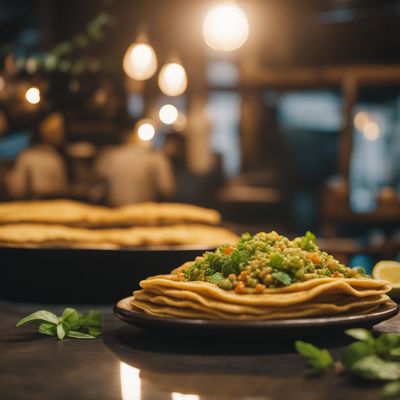
Roti planta
Roti planta is a Malaysian flatbread that is often served with curry or other spicy dishes.
More Thai cuisine dishes » Browse all

Mee nam
Mee Nam
Mee nam is a Thai noodle soup dish that originated in the city of Bangkok. It is known for its clear broth and thin, flat noodles.

Pad Thai
Pad Thai is a popular Thai dish that is made with stir-fried rice noodles, vegetables, and a variety of spices. The dish is typically served with...

Khao kha mu
Stewed Pork Leg
Khao kha mu is a Thai dish that is made with braised pork leg and served with rice and a variety of side dishes. It is a flavorful and satisfying...
